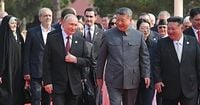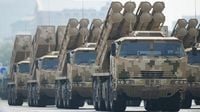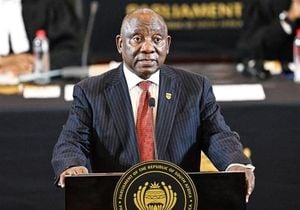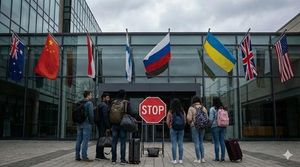On September 4, 2025, the world’s attention was fixed on warnings coming from the heart of Europe. NATO Secretary General Mark Rutte, addressing the IISS Prague Defence Summit, delivered a stark message: Russia and China are preparing their defense industries for a “long-term confrontation.” His words echoed with a sense of urgency that seemed to ripple through Western capitals, as he laid out the scale and speed of the military buildup underway in the East. “We face serious and lasting threats: Russia and China are investing heavily to build up and modernize their militaries,” Rutte said, as reported by BBC. “Their defense industries are producing weapons and heavy military equipment at a remarkable, staggering rate.”
Rutte’s concerns were not merely theoretical. Just a day earlier, Beijing had hosted a massive military parade marking the 80th anniversary of China’s victory over Japan in World War II. The event, attended by 26 heads of state—including Russia’s Vladimir Putin and North Korea’s Kim Jong Un—was a showcase of new military hardware and a pointed demonstration of unity among three of the West’s most prominent adversaries. Observers from EurAsian Times dubbed the trio the potential “Axis of Upheaval,” a phrase that has quickly gained currency among Western security analysts fearful of a new, more formidable alliance emerging on the global stage.
The military parade, which unfolded in Beijing’s iconic Tiananmen Square, was no ordinary spectacle. Countless soldiers, sailors, and airmen marched in near-perfect unison, flanked by intercontinental ballistic missiles, hypersonic weapons, unmanned aerial vehicles (UAVs), and anti-ship ballistic missiles. The display was as much about symbolism as strength: for the first time, Xi Jinping, Putin, and Kim Jong Un walked side by side, their presence signaling a rare and unsettling show of unity against the US-led world order. As Daily Mail noted, “The summit in Beijing marked the first time Putin, Xi, and Kim, all major rivals of the West, have ever gathered in the same place at the same time.”
For Rutte and other NATO leaders, the parade was an unmistakable warning. The NATO chief specifically pointed to China’s rapid shipbuilding program, which he said was outpacing the United States and its Western allies by an astonishing margin. “When it comes to shipbuilding, and our navy—and particularly the US Navy—I’m really worried,” Rutte said in Prague. “China now has more ships sailing than the US, and shipbuilding in the US is not at a rate that they can anywhere catch up on what China is doing at the moment.” According to Nick Childs, a senior fellow for naval forces and maritime security at the International Institute for Strategic Studies, “The Chinese shipbuilding capacity is something like 200 times overall that of the United States,” as reported by the BBC. American shipbuilding, by contrast, has been hampered by surging costs, delays, and aging infrastructure.
The Pentagon’s own assessments back up these concerns. In December 2024, the Department of Defense revealed that the Chinese navy was the largest in the world, boasting a battle force of over 370 ships and submarines, including more than 140 major surface combatants. China is expected to have its third aircraft carrier operational within the year, according to Newsweek. Meanwhile, US shipyards have struggled to keep pace, often lacking the space and workforce needed to meet the Navy’s demands. Vice Admiral Robert Murrett, speaking to Newsweek, described US shipyards as “working with aging infrastructure” and noted that “there are not enough people available to meet the Navy’s demands.”
This relentless pace of Chinese military expansion has forced the US to rethink its strategic priorities. “The US is prioritizing deterring war with China in the Pacific,” Defense Secretary Pete Hegseth told European allies earlier in 2025. “Together, we can establish a division of labor that maximizes our comparative advantages in Europe and Pacific respectively.” But as the parade in Beijing made clear, the challenge is not limited to China alone. The presence of Putin and Kim Jong Un underscored growing coordination among America’s adversaries—a trend that has Western analysts on edge.
The roots of this emerging partnership run deep. As EurAsian Times pointed out, Russia, China, and North Korea have a history of military cooperation dating back to the Korean War (1950-1953), when all three fought against a US-led coalition. More recently, these ties have been formalized in treaties and joint ventures. In June 2024, Russia and North Korea signed the Treaty on Comprehensive Strategic Partnership, which includes a mutual defense pact similar to NATO’s Article 5. Article 4 of the treaty states that if either nation is put in a state of war by armed invasion, the other will “provide military and other assistance with all means in its possession without delay.” North Korean soldiers have already fought alongside Russian forces in Ukraine’s Kursk Oblast, with reports indicating nearly 12,000 North Koreans served there, and almost 2,000 died in combat.
China and Russia, too, have deepened their partnership. Just days before Russia’s Ukraine offensive in February 2022, Moscow and Beijing declared a “no limits partnership.” China is Russia’s largest trade partner, the chief buyer of Russian oil and coal, and a significant purchaser of Russian liquefied natural gas and pipeline gas. On September 2, 2025, the two countries inked a major deal to construct the Power of Siberia 2 gas pipeline, set to transport gas from Russia’s West Siberia to northern China via Mongolia. China is also the largest supplier of dual-use items to Russia, which have been crucial for Russia’s drone production during the ongoing war in Ukraine.
North Korea and China maintain friendly diplomatic and trade ties, despite US and Western sanctions. With Russia and North Korea already among the most heavily sanctioned countries in the world, and China locked in a trade war with the US, the West’s leverage through economic measures appears limited. “These countries could easily form an alliance, as the West has limited leverage in terms of imposing new sanctions on these countries,” EurAsian Times noted.
In terms of raw military might, the numbers are sobering. Collectively, Russia, China, and North Korea command approximately 6,735 nuclear weapons, surpassing NATO’s 6,305, according to data from SIPRI. Their combined active troops number 4.67 million, compared to NATO’s 3.55 million, and they have more than 3 million reserve troops, outstripping NATO’s 2.7 million. The China-Russia-North Korea alliance also boasts 16,894 tanks versus NATO’s 14,125, and a naval fleet of 1,380 ships compared to NATO’s 1,143. While NATO still holds an edge in combat aircraft, attack helicopters, and especially aircraft carriers (16 to the alliance’s 7), the gap in other areas is narrowing fast. Notably, all three Eastern nations have made significant advances in anti-ship hypersonic missiles, potentially blunting NATO’s advantage at sea.
For Europe, the stakes are especially high. European partners have repeatedly warned that Putin is preparing for a wider war with NATO by 2028. With Russia’s battle-hardened troops and China’s technological and industrial might, the potential for a coordinated offensive in both Asia and Europe is a scenario Western defense planners can no longer ignore. As Rutte demanded answers from the “coalition of the willing” about future security guarantees for Ukraine, the underlying anxiety was clear: the world may be entering a new era of great power rivalry, with alliances and arsenals to match.
The warnings from Prague, the spectacle in Beijing, and the deepening ties among America’s adversaries all point to one reality: the global balance of power is shifting, and the West will need both resolve and ingenuity to keep pace.





